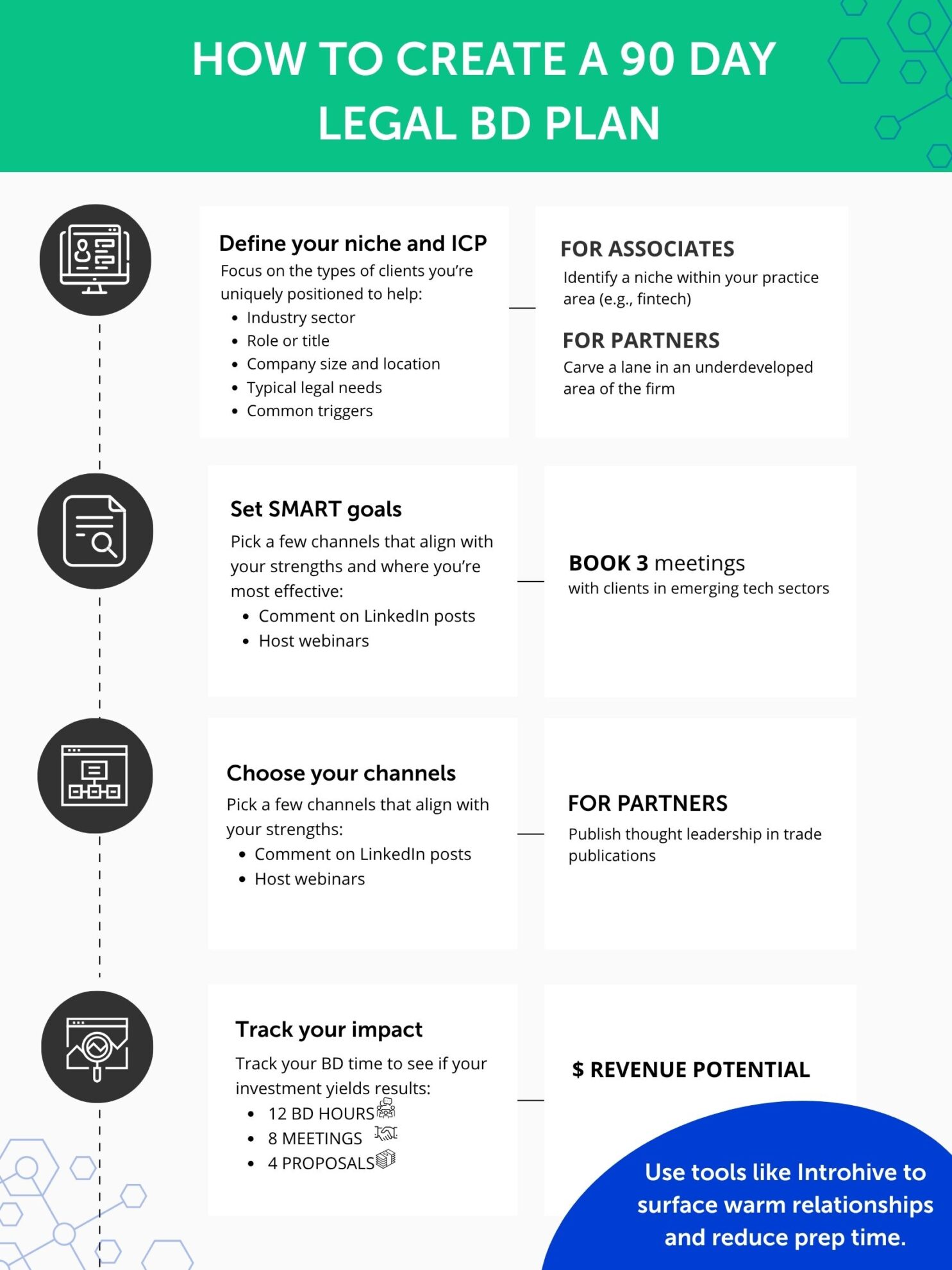Why business development for lawyers is no longer optional
Clients expect you to be good at your job. That’s the baseline. What sets you apart today is your ability to build trust, deepen relationships, and stay visible in the minds of the people who matter, not just after a deal or case is closed, but through intentional, ongoing business development as a lawyer.
For lawyers working within a firm, business development isn’t about growing the firm itself. It’s about growing your practice, your reputation, and your client base. Developing a strong pipeline of work gives you more control, more opportunity, and more leverage in your career. And this isn’t just for partners. Associates who invest early in business development are better positioned for promotion, client-facing work, and leadership opportunities. Business development for lawyers doesn’t mean “selling.” It means showing up with intention: offering value, making connections, and staying proactive about your career growth.
Table of contents
Overcoming the top 3 legal BD challenges (and how to do it)
Challenge 1: “I don’t have time”
Every lawyer feels the time crunch. Billable hours, internal meetings, casework; there’s never a shortage of urgent priorities. But business development doesn’t have to be a massive time sink. Some of the most effective strategies take just a few hours a month.
The key is consistency. Block off one hour a week and treat it like a client meeting. Use that time to follow up with contacts, send a note of congratulations or interest, or share a short update on LinkedIn. When business development becomes a habit, it stops feeling like an extra task, and starts becoming a source of momentum.
Tools that surface relevant client insights and reduce admin can help keep that hour focused. For example, pre-meeting digests delivered right to your inbox, like those provided by Introhive, can give you a snapshot of relationship history, company news, and internal touchpoints before you even open your calendar. If your prep time is cut in half because the information you need is already in front of you, it’s a lot easier to make that weekly investment stick.
Challenge 2: “I’m a lawyer, not a salesperson”
Good news: you don’t need to be a salesperson. In fact, the most successful lawyers are usually the ones who never sound like they’re selling at all. They ask thoughtful questions. They listen. They show up with relevant advice. That’s what clients remember.
Authenticity is your advantage. Business development for lawyers is about building relationships, not closing deals. If you focus on helping people solve problems, the opportunities will follow.
What helps is context, knowing what matters to your client before the conversation even begins. Tools like Introhive that provide relationship history, firm touchpoints, or recent client activity can give you the confidence to show up informed. Instead of selling, you’re simply better prepared to offer something meaningful when it counts.
Challenge 3: “I don’t know where to start”
If business development feels overwhelming, simplify it. Start by defining your ideal client: their role, industry, common challenges. From there, pick one or two ways to stay in touch with people in that space. LinkedIn, referrals, and targeted check-ins are often the most effective and least time-consuming forms of lawyer networking.
Once you know who you’re helping and how you’ll reach them, you’re not guessing anymore. You’re building a system.
Introhive can help make that system smarter. By surfacing relationship connections across your firm and revealing recent client engagement history, Introhive helps you prioritize where to focus and who to contact. Instead of staring at a blank screen, you’re making intentional moves backed by real data so you’re always starting from a warmer place.
How to create a 90-day legal business development plan
A strong business development plan is how many lawyers turn good intentions into long-term client growth. Think of this as a 90-day sprint, not to master business development overnight, but to build the habits, systems, and insights that will support long-term growth.
This isn’t about doing everything. It’s about doing a few things intentionally and consistently.
Step 1: Define your niche and ideal client profile (ICP)
Start with clarity. You can’t market to everyone, and you shouldn’t try. Focus on the types of clients you understand best and the problems you’re uniquely positioned to solve.
Build your Ideal Client Profile (ICP) by identifying:
- Industry sector (e.g., fintech, healthcare, manufacturing)
- Role or title (e.g., GC, COO, founder)
- Company size and location
- Typical legal needs (e.g., M&A, compliance, employment law)
- Common triggers that signal they may need your services (e.g., a funding round, new regulations, leadership changes)
With a clear ICP, you can cut through the noise. It becomes easier to decide who to reach out to, what to say, and where to spend your time.
Step 2: Set SMART goals
Vague goals like “do more BD” won’t move the needle. You need goals that are SMART goals: Specific, Measurable, Achievable, Relevant, and Time-bound so you can track progress and stay accountable.
Try goals like:
- Book 6 new intro calls with potential clients this quarter
- Publish 1 LinkedIn article per month on a key industry topic
- Expand your referral network by 10 new connections
Write your goals down. Review them weekly. Even small wins, one new conversation, one new contact, can build momentum over time.
Tip: If you’re using a tool like Introhive, you can set more focused goals using relationship intelligence, tracking warm connections, and surfacing targets who are already engaged across the firm.
Step 3: Choose your channels
You don’t have to be everywhere. Pick 2–3 channels that align with your strengths and where your clients spend their time.
Online:
- LinkedIn: Comment on posts, share updates, or publish short articles. LinkedIn, webinars, and publishing articles are excellent ways to share value and build your thought leadership presence.
- Email: Personalized check-ins or curated legal updates
- Webinars: Host or join focused sessions on timely issues
Offline:
- Strategic coffee meetings or client lunches
- Industry or bar association events
- Speaking at CLEs, panels, or roundtables
Don’t overcomplicate it. Start where you’re comfortable and build from there. The goal is connection, not perfection.
Step 4: Track your time and measure what works
Business development is an investment, and you should treat it like one. Even if you’re not spending money, you’re spending time, and that time should generate a return.
Start simple:
- How many hours did you spend on BD this week?
- How many meetings or check-ins did you book?
- Did you publish anything or attend any events?
- Did those activities lead to conversations, referrals, or new work?
Review your results every 30 days. Which activities sparked traction? Which fell flat? Then adjust. Double down on what’s working. Drop what’s not. It’s about identifying what actually drives law firm growth and focusing your time there.
Bonus: Tools like Introhive can help automate tracking and show which client relationships are warming up, where you have firm-wide connections, and where opportunities might be hiding in plain sight.

Want to turn good intentions into real business development momentum?
Download our cheat sheet on Cultivating Business Development Champions, to learn how top firms are supporting activator behavior, streamlining business development, and empowering lawyers to build stronger client relationships. Download the Guide.
15 actionable business development strategies & tactics
Part 1: strengthening your core
#1 Give away free resources in your community
“Write a ‘how to’ report in your area of expertise and give it away. Make it so good that centers of influence in your target market or community willingly promote it to their lists and thank you for making it available.” – Founder of a prominent law firm
#2 Start with contemporaries when building your referral engine
“Focus on good lawyers who are your contemporaries when getting in touch with potential referral sources. More experienced lawyers already have people to whom they refer cases.” – Chief Development Officer at a prominent non-profit organization specializing in consumer protection law
#3 Put your firm’s personal brands on a pedestal to boost your law firm’s business development
“Have EVERY single lawyer in the firm develop a strong online personal brand and online presence. Most lawyers have a default brand online (and off) that turns them into generic practitioners. One place to start is with a well-branded LinkedIn profile. This is essential for successful legal marketing. Things to consider for LinkedIn include: A fully fleshed out summary with specific details of the attorney’s professional successes, a clear statement of expertise and results, recommendations from at least 10 clients, a professional headshot, and a tagline under the headshot that makes the area of expertise clear.” – President of a prominent marketing consultancy
Did you know that LinkedIn connections, while valuable, only represent a fraction of your law firm’s relationship data? Even the best efforts on LinkedIn for lawyers can miss internal connections in other departments and practice areas, as well as recent interactions that drive new business. With the right tools, firms can automatically collect and surface deeper relationship insights, unlocking opportunities that go far beyond what’s visible in a profile.
Part 2: expanding your network

#4 Make yourself memorable
“Your firm’s holiday card is probably one of many that clients or potential clients receive. Find another holiday (or make one up) that you enjoy and that complements your practice. Separating yourself from other, similar messages is of real value. For a number of people I do business with, my connection to Memphis is important. I want them to think about Memphis and think about me, and I don’t want there to be more than a half second between those two thoughts.” – Partner at a prominent law firm
#5 Make referral generation part of your routine
“Contact three to five potential referral sources a week, every week, regardless of how busy you are, and arrange to meet for coffee, drinks or a meal. That works much better than reaching out only when business is slow.” – Lawyer at a respected law firm
#6 Get active in a trade association, and get on the board of directors
“You’ll notice that I said, trade association, and not bar association. You should join an association of clients. You want to get in front of a room full of clients, people who can potentially hire you. You find out about these trade associations by asking your current clients what meetings they go to. Then it’s a simple matter of saying, ‘I’d like to join you at the meeting. Would you introduce me to your friends?’ These friends, of course, are all potential clients for you. It’s no good just going to the meeting; you have to be visible. Your goal when you join a trade association is not to be just a face in the crowd. Your goal is to get on the board of directors. The way you do that is you seek out the president and you volunteer. You volunteer to help put together programs; you volunteer to help with the newsletter; you volunteer to help in any sort of activity that is going to lead to a board position.” – Attorney and Journalist
#7 Prioritize relationships over ads
A sometimes overlooked strategy in law firm business development, “The best marketing move I ever made was spending more money on developing relationships than on running ads. Bringing people together at a wine tasting or charity event, where the marketing is secondary, results in better referrals than spending money on advertising.” – General Counsel at a distinguished law firm
Part 3: leveraging technology to power legal business development
#8 Perfect your pitch
“A well-defined elevator speech is a key component of a successful business development plan. In roughly 30 seconds, you should be able to explain who you are, what you do, where you do it and why. Make sure you craft and perfect your elevator speech. It will be one of the best tools to carry with you throughout your career.” – Marketing Director at a prominent law firm
#9 Promote your best Facebook posts
“Unfortunately, Facebook has started limiting the reach of posts from business pages, which means even the people that like your page may not see your posts in their news feeds all the time.
For this reason, it’s worth ‘boosting’ your best posts for additional engagement. Maybe you wrote an awesome blogpost and people are responding really well to it. This would be a good piece of content to promote on Facebook.
The reason for promoting a post is that Facebook offers incredibly powerful targeting through their knowledge graph. You can target people based on age, location, interests, occupation, and much more. It’s an excellent way to ensure that your content is reaching the right people (aka your target clients), and it’s usually significantly less expensive than advertising on Google Adwords.” – Co-founder of two innovative legal technology platforms
#10 Showcase value via thought leadership
“Through their deep understanding of an industry, great business developers use their insights to become thought leaders. In other words, they look into the future and predict issues that will impact on their clients and proactively present solutions to these issues, often before the client is even aware of the issue or the risk that it poses to their business.” – BD Consultant and Coach

Part 4: modern marketing tactics
#11 Offer turn-key solutions with other providers
“Research has shown that a significant percentage of clients like to do ‘one-stop shopping.’ If they can find a reliable general contractor to farm out electrical, plumbing and roofing work on a renovation, they will hire him. Likewise, many clients have chosen larger firms that have found ethical ways to provide their services in conjunction with others that are essential to solving a specific client problem (as in the case of a company that hires a law firm for real estate development work and screening of qualified local environmental testing and inspection firms).
Some estate planning lawyers similarly have helped clients to find financial planners and accountants who can work with the lawyers to find comprehensive solutions to long-term planning needs. If you can’t ‘partner’ up on a solution, you can at least volunteer to help your clients find reliable and reputable non-lawyer providers to complement your work. The more ‘packaged’ solutions you can offer to clients, the more they will see that you have put forethought, planning and effort into your own product development.
Of course, you have to be careful about the company you keep when offering one-stop solutions for planning problems, but clients are looking to you for professional acumen and judgment. If you are willing to exercise it, you can earn their trust.” – Principal of a prominent communications consultancy
#12 Designate a “marketing partner”
“Find a respected, influential equity partner in the firm, young or old, who actually believes in marketing. Create a troika consisting of your Chair/MP, this individual and your firm’s most senior marketing professional to strategize, own and champion marketing initiatives across the firm. Do not form a partner marketing committee. If you have one, get rid of it.” – Senior Communications Professional
#13 Transform your law firm’s business development with a collaborative approach
“Many times we hear compensation credit gets in the way of professionals working together to bring in a new client. Unfortunately, more often than not, compensation credit getting in the way of team-oriented activity is simply an excuse for active exclusion. Either way, for the majority of lawyers who are in favor of going it on their own, they are likely depriving their clients of receiving maximum value, and they are likely leaving the door wider open to the competition. Time and again, clients express their favorable opinion about teamwork as it relates to their service providers. Further, market data shows that the firms that take a client-focused, collaborative approach to the relationship receive the more interesting and profitable work.” – Principal at a leading legal consulting firm
#14 Know what your in-house marketing team can offer
“Attorneys should get to know what their in-house team can offer. Take the time to identify who your firm’s marketing professionals are and how they can help you. Don’t take what is close and convenient for granted. Don’t assume that sage advice, guidance, strategy, direction, and coaching can only come from outside the firm.” – Chief Marketing Officer at a prominent national law firm
#15 Involve your in-house team early
“The best way for a lawyer to work with their in-house marketing team is to bring us into the process as early as possible. Whether you’re preparing for a lunch meeting, replying to an RFP or considering cross-selling a client within your firm, the more information we can provide, the better situated you will be to make the ask of the client. Attorneys are our clients and we want them to succeed, so including us in the process is integral to reaching the mutual goal of success.” – Business Development Manager at a prominent law firm
The single most important tool in your BD toolkit
Relationships drive legal business development. But relationships are hard to manage when you’re juggling dozens of matters and hundreds of contacts.
Introhive helps solve that problem. It automatically maps your firm’s network, syncs interactions, and flags at-risk or high-value relationships. No more spreadsheets or forgotten follow-ups. Just smarter, more strategic outreach.
For lawyers serious about business development, a relationship intelligence platform like Introhive can turn intention into action.
Ready to see how Introhive can support your firm’s business development goals?
Request a demo and see how relationship intelligence can help you unlock hidden opportunities, streamline outreach, attract new clients, and expand existing relationships, all without adding to your workload.
Frequently asked questions (FAQ)
How much time should a lawyer spend on business development?
Start with just one to two hours per week. Block it off like a client meeting and focus on high-impact activities: reaching out to contacts, posting on LinkedIn, or following up with past clients. As you build momentum, aim to spend 10–15% of your time on business development for lawyers.
This doesn’t mean overhauling your schedule. It means making space for consistent actions that drive client development and long-term law firm growth. Using a legal-specific CRM like Introhive can help you make the most of your time by surfacing relevant contacts, prepping you with client insights, and automating admin tasks. That way, you’re spending your limited BD time where it counts, building relationships, not chasing data.
How do you measure the success of legal business development?
Start by tracking real outcomes, not just activity. Successful legal business development shows up in ways like:
- Intro meetings booked with new or prospective clients
- Referrals made or received
- Opportunities surfaced through lawyer networking
- Client matters opened or expanded
- Revenue influenced or generated
Keep a simple log of your outreach, follow-ups, and results. Review it monthly to see what’s gaining traction and where to adjust. A good business development plan focuses not just on doing more, but on doing more of what works.
If your firm uses a CRM, pairing it with a platform like Introhive can make this easier. Introhive automatically captures relationship data, surfaces warm connections, and helps track engagement trends so that you’re not manually logging every touchpoint. Instead of guessing where to focus, you’re using real insights to guide your efforts and demonstrate impact on client development and law firm growth.
What is the best CRM for law firms?
When looking for a CRM for lawyers, usability and adoption are just as important as features. The best CRM is the one your firm actually uses, and that’s where many legal teams struggle. Traditional CRMs require manual data entry, and without consistent adoption, they quickly become outdated and underused.
That’s why many firms are turning to solutions like Introhive to get more out of their existing CRM. Introhive enhances your CRM by automatically capturing relationship data, enriching contact records, and surfacing insights that drive smarter outreach.
Instead of lawyers having to log every email or meeting, Introhive works in the background to keep records up to date, map firm-wide connections, and help identify warm paths to new business. It transforms a static system into a living source of client intelligence, which is essential for effective business development for lawyers, client development, and sustainable law firm growth.
If your CRM is underutilized, Introhive can help you turn it into a tool that actually supports how lawyers build relationships and attract new clients.





